Discovering a chipmunk in your attic can be a surprising encounter.
These small, striped rodents may look charming and harmless, but when they make your attic their home, they bring a host of problems.
Chipmunks belong outdoors, where they play a valuable role in ecosystems, not inside your house where they can chew on wires and wood, potentially causing structural damage or even fire hazards.
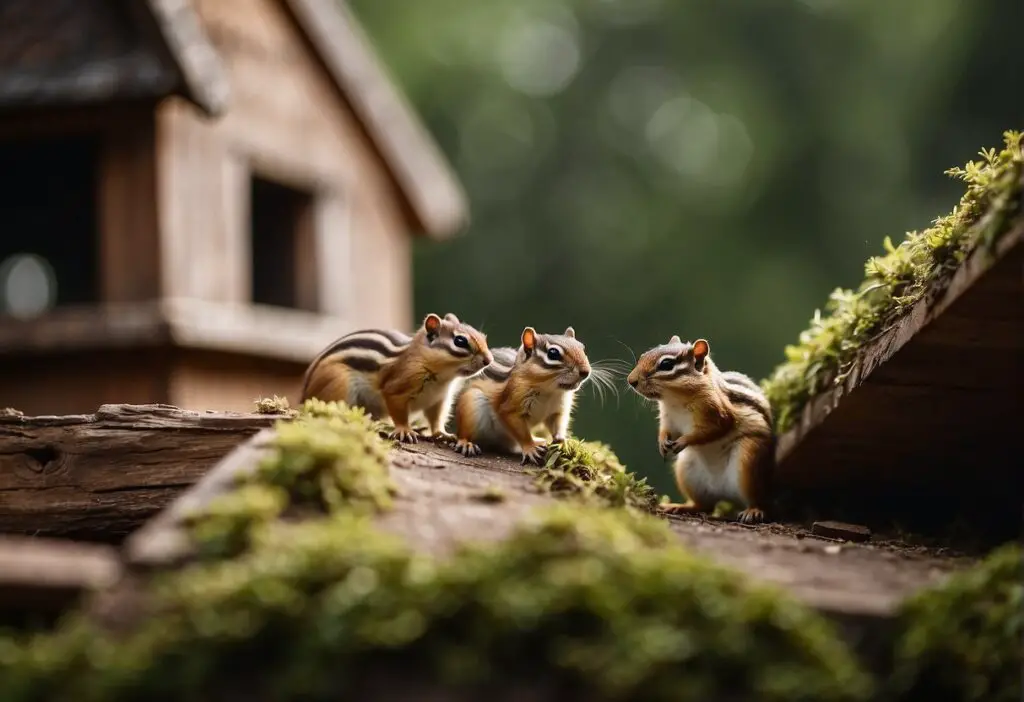
If you’re hearing the pitter-patter of little feet above your ceiling, it may be chipmunks scurrying around. An infestation in your attic can be particularly problematic because it provides them with shelter, warmth, and potential access to food sources in your home. Addressing a chipmunk infestation swiftly is important, not only to prevent damage to your home but also to ensure the safety and health of your family.
Getting rid of chipmunks requires a two-fold approach: removing the current intruders and preventing future invasions. It’s essential to seal entry points, such as holes and cracks, and consider professional trapping and relocation methods if the situation calls for it. Let’s take a moment to understand these furry little climbers and explore effective strategies to keep your attic chipmunk-free.
Understanding Chipmunk Behavior
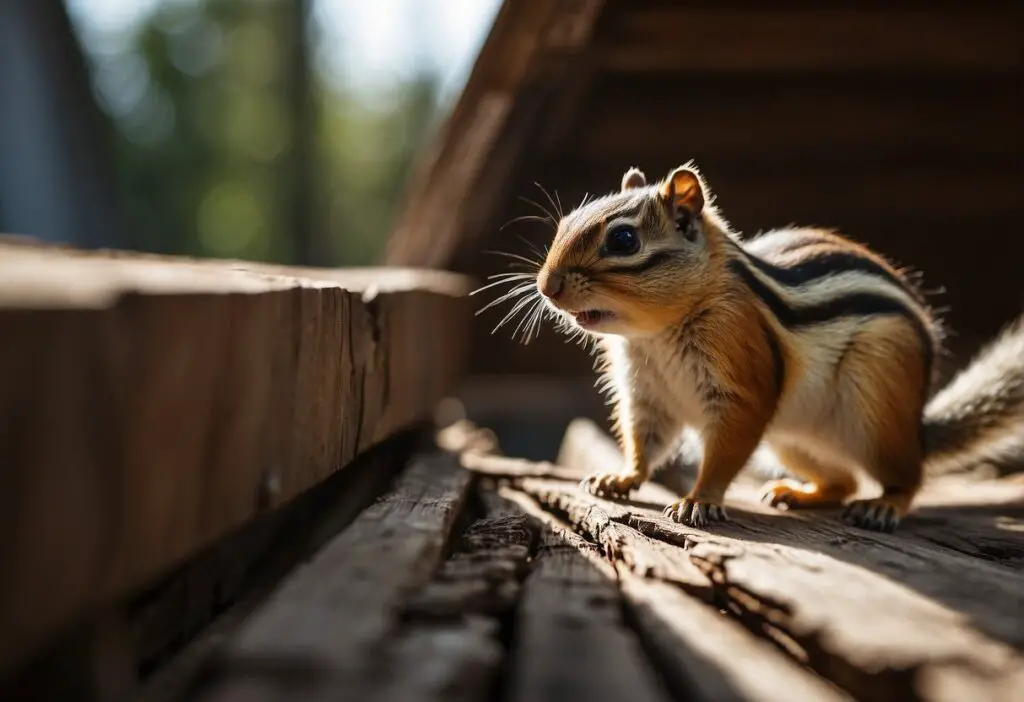
Before you start your quest to keep chipmunks out, it’s important to understand their natural behavior patterns. Recognizing why your home might attract these small rodents will help in creating effective deterrent strategies.
Natural Habitat and Diet
Chipmunks thrive in forested areas where shrubbery and ground cover provide ample shelter and foraging grounds. In the wild, they are omnivores, feeding on a variety of foods including nuts, seeds, fruits, and occasionally insects. They are also known for their burrowing habits, which serve as a means to store food and seek refuge from predators.
Common Attractants in Your Home
Your home can unwittingly become a haven for chipmunks. They are drawn to spaces that mimic their natural habitats. An attic, for example, offers shelter and can hold potential food sources like seeds or fruits that are not properly stored. The warmth and available materials for nesting can also be irresistible to these small, seeking rodents. To prevent them from turning your home into their own, ensure that any food items are secured in rodent-proof containers and access points to your attic are sealed.
Assessing the Situation
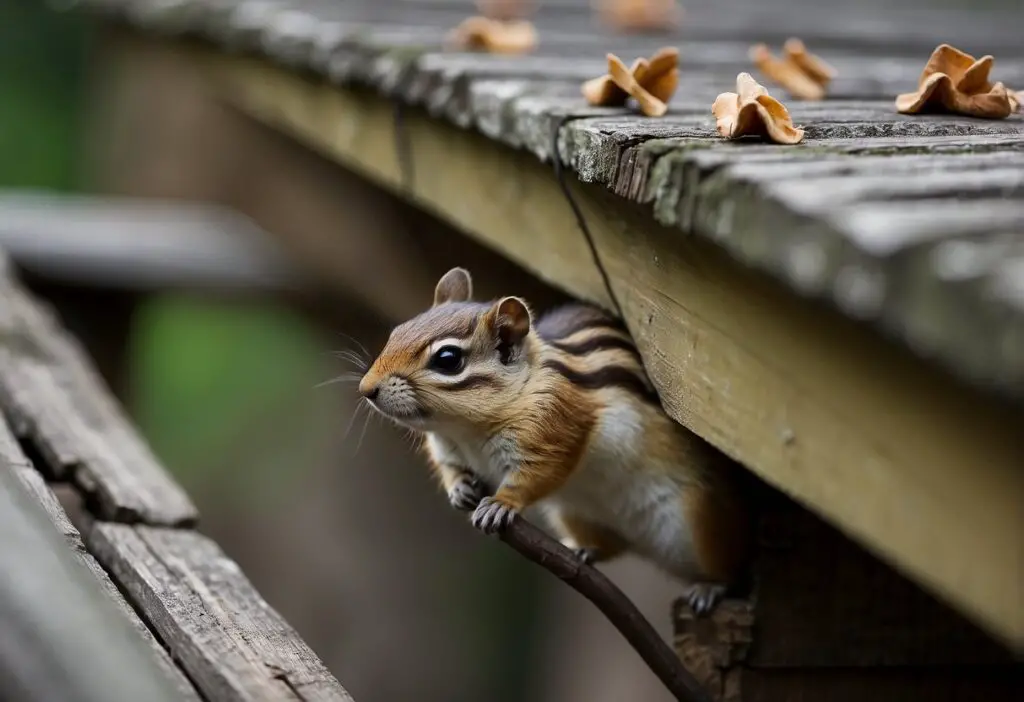
Discovering chipmunks in your attic can be frustrating. Your initial steps are to look for signs of their presence and evaluate how much they’ve affected your space.
Identifying Signs of Chipmunk Presence
When chipmunks visit, they leave a few telltale signs. First, look for droppings. Chipmunk droppings are small and similar to those of a mouse but may appear in quantities due to their social nature. Next, listen for scratching noises during the day as chipmunks are diurnal. Lastly, keep an eye out for tunnel entrances; these may not always be in the attic but could be nearby, indicating where they’re getting in.
Evaluating the Extent of Chipmunk Activity
To gauge the level of infestation, look for damage such as gnawed wires or wood, which can be clear evidence of chipmunk activity. Burrows in insulation are another sign, as chipmunks carve out nesting areas. The extent of visible burrows can give you an understanding of the size of the issue at hand. Keep track of these signs to determine the scale of the infestation and plan the next steps accordingly.
Humane Removal Methods
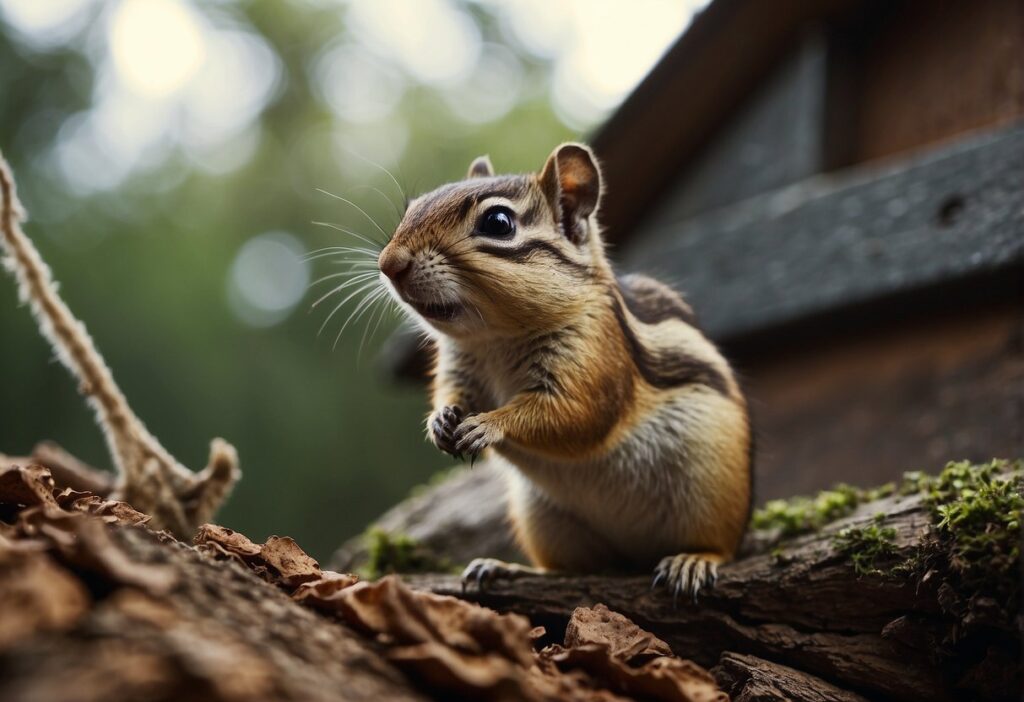
When you discover chipmunks in your attic, it’s important to remove them without causing harm. That’s where humane removal methods come into play, using strategies like effective trapping techniques and ensuring proper relocation practices.
Effective Trapping Techniques
To humanely trap chipmunks, using live traps is a compassionate choice. Live traps allow you to capture chipmunks without injuring them so that you can later relocate them to a more suitable habitat. When setting up traps, location is key; look for areas with chipmunk activity.
Bait your traps with appealing food like peanut butter or sunflower seeds, which chipmunks find irresistible. Place a small amount of bait at the entrance of the trap and more inside, to ensure the chipmunk ventures in far enough to trigger the trap door.
Set Up:
- Identify active chipmunk paths.
- Position your live trap along these paths.
- Secure it to prevent tipping.
Baiting:
- Entrance: A dab of peanut butter.
- Inside: A handful of sunflower seeds.
Relocation Best Practices
Once you’ve caught a chipmunk, the next step is to relocate it. It’s essential to check local wildlife regulations first, as some areas have restrictions on where you can release wildlife.
Find a remote location at least 5 miles from your home to prevent the chipmunk from returning. Release it in a habitat that’s chipmunk-friendly, such as a wooded area with plenty of food sources and shelter.
Before Relocation:
- Check local wildlife laws.
- Find a suitable release site.
During Relocation:
- Transport the chipmunk in the trap to avoid stress.
- Release it gently in the new environment.
Preventing Future Intrusions
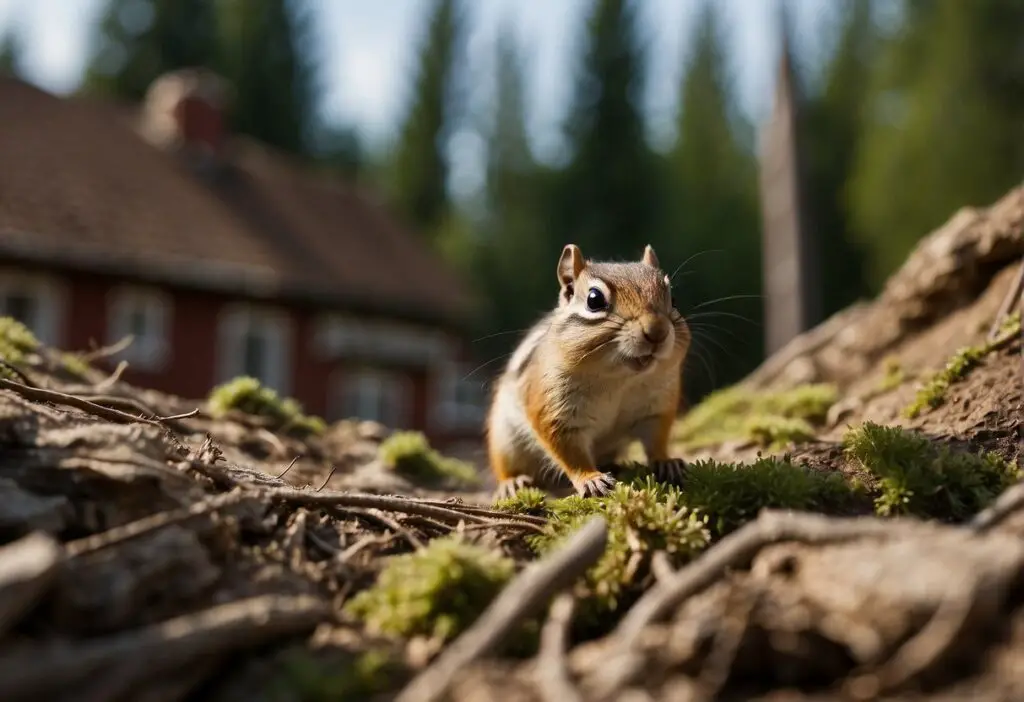
Ensuring that chipmunks no longer treat your attic as their personal playground involves a two-pronged approach: securing the potential entry points to your home and altering the environment to make it less attractive to these furry invaders.
Exclusion Tactics to Secure Your Home
Sealing Entry Points: Carefully inspect your home’s exterior for any openings. Use caulk to seal small gaps and holes in your foundation, walls, and around windows and doors. For larger spaces or holes, especially near utility pipes and vents, consider using hardware cloth which is a sturdy metal mesh that can’t be chewed through.
Reinforcing Exclusions with Hardware: When it comes to preventing access to your attic, you can install fences underground as chipmunks are adept at burrowing. Metal flashing or hardware cloth should extend a few feet underground to ensure they can’t dig their way in.
Environment Management to Discourage Return
Organizing Your Garden: Change how your outdoor space appeals to chipmunks by removing their favorite hideouts and food sources. Maintain a plant-free gravel border around your home’s foundation to deter digging and burrowing. Keep any shrubbery trimmed and away from your house.
Discouraging Return Visits: Minimize excess food sources, such as bird feeders or accessible pet food, that could attract chipmunks. Consider installing a fence around your garden to protect it and use specialized repellents to encourage chipmunks to move on to a new territory.
Additional Considerations
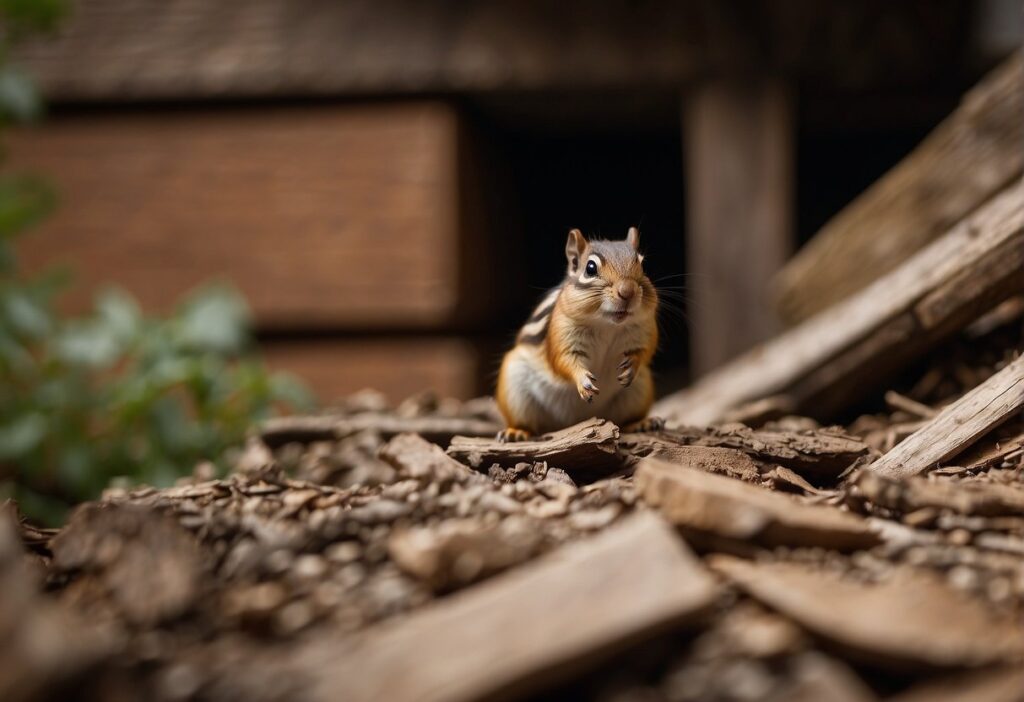
When addressing chipmunks in the attic, it’s essential to consider not just removal, but also the health implications and methods to safeguard your garden. Pay close attention to these details to ensure your efforts are both effective and safe.
Health Risks and Safe Cleanup
Chipmunks carry various diseases, such as tularemia and salmonella, which can pose risks to your health. When cleaning areas they’ve inhabited, wear gloves and a mask to prevent direct contact with droppings and urine. Use a solution of bleach and water to sanitize the area, ensuring that any harmful pathogens are eliminated. Proper cleanup minimizes health risks and makes your attic safer for you and your family.
Landscape and Garden Protection Strategies
Your garden plants can be a magnet for chipmunks, offering both shelter and a food source. To protect your garden, consider planting bulbs like daffodils, which are unappealing to chipmunks due to their toxic properties. Similarly, garlic can act as a natural deterrent due to its strong scent. Applying thiram-based repellents to plant bulbs can further discourage chipmunks, but always follow the manufacturer’s instructions to prevent harm to the plants themselves. Cover seeds with hardware cloth, then soil to prevent chipmunks from digging them up. Remember, these small creatures are deterred by strong scents and bitter tastes, so use these to your advantage in your garden.


